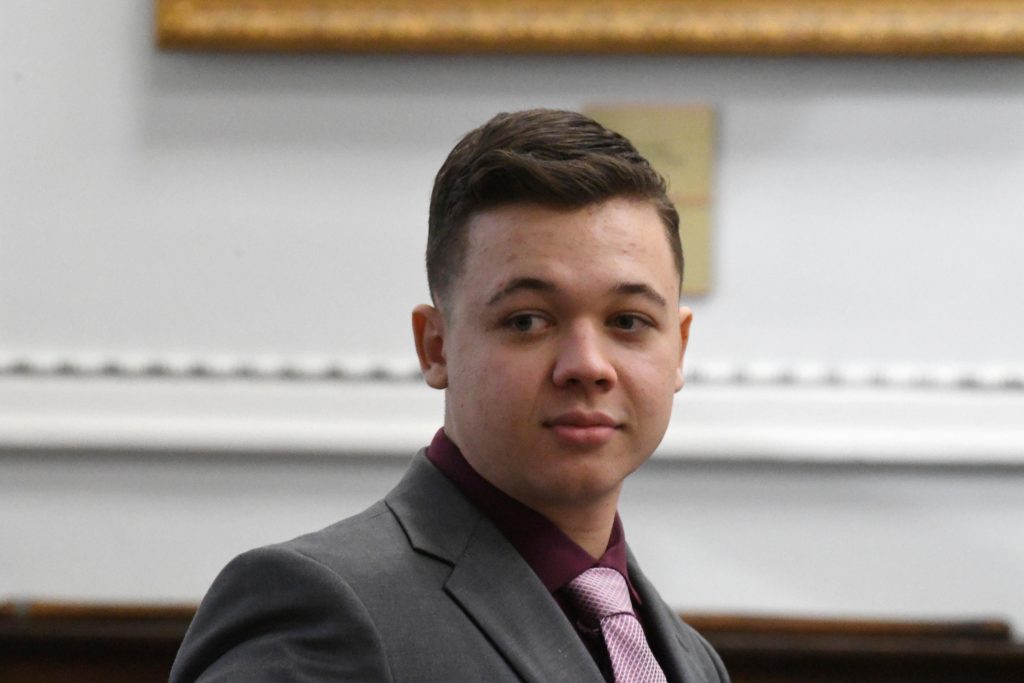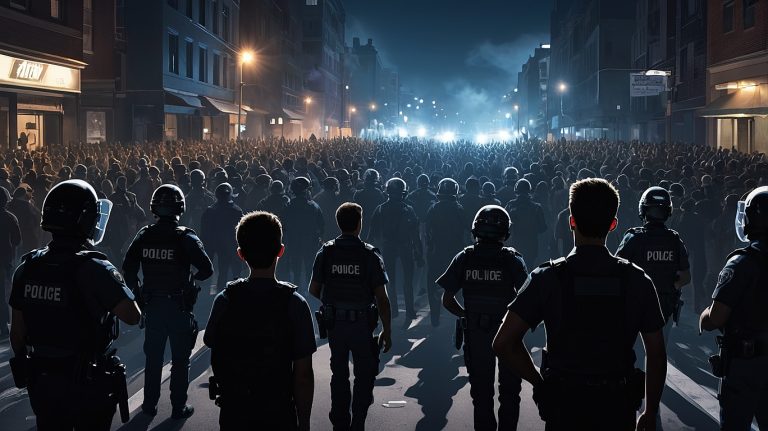The Context Leading to the Kenosha Unrest
The Kenosha unrest unfolded in August 2020, after Jacob Blake, an African-American man, was shot seven times in the back by Kenosha police officer Rusten Sheskey. This incident occurred on August 23, 2020, when police responded to a domestic disturbance call involving Blake. While attempting to enter his SUV, Blake was shot in front of his children. Although Blake survived, he was left paralyzed from the waist down. The shooting was captured on video and quickly went viral, sparking outrage and protests both locally and nationally. It was perceived as another instance of excessive police force against Black Americans, coming on the heels of George Floyd’s murder earlier that year.
In the days following Blake’s shooting, Kenosha became the epicenter of large-scale protests calling for racial justice and police reform. While many protesters were peaceful, a significant portion of the unrest devolved into riots, arson, and vandalism. Buildings, cars, and businesses were set on fire, causing widespread destruction throughout the city. Law enforcement struggled to maintain control as clashes between police, protesters, and armed civilians escalated. Wisconsin Governor Tony Evers declared a state of emergency, deploying the National Guard to help restore order, but the tension in the streets only grew.
Amidst this unrest, armed civilian groups, some identifying as militia members, began to appear in Kenosha, claiming to protect property and businesses from looters. The presence of these groups added a volatile dynamic to the already charged atmosphere. Law enforcement officers, while not formally endorsing these groups, were captured on video giving water to some of the armed civilians and thanking them for their presence, further complicating the already tense situation.
This environment of chaos, confusion, and fear set the stage for the tragic events that would follow. Among the armed civilians who arrived in Kenosha was Kyle Rittenhouse, a 17-year-old from Antioch, Illinois. Rittenhouse’s decision to enter the fray would turn him into one of the most polarizing figures in America, and his actions would spark a national debate over gun rights, vigilantism, and self-defense laws.
Books for Reference
“Acquitted” by Kyle Rittenhouse – This book, which was released in December 2023, is written by Rittenhouse himself. It aims to share his perspective on the events surrounding the protests in Kenosha and the legal battles that followed. Rittenhouse expresses his desire to clarify the misconceptions about his actions during that tumultuous period.
The Night of the Shootings
On the night of August 25, 2020, the third night of unrest in Kenosha, the situation became increasingly volatile. The streets were filled with protesters, counter-protesters, and armed civilians, creating an atmosphere ripe for conflict. Among these armed individuals was Kyle Rittenhouse, a 17-year-old who had traveled from his home in Antioch, Illinois, to Kenosha. Rittenhouse, carrying an AR-15-style rifle, claimed his purpose was to protect local businesses from looting and vandalism, as the unrest had already caused significant property damage throughout the city.
Earlier that day, Rittenhouse had been seen cleaning graffiti off public property, presenting himself as someone looking to help. However, by nightfall, he was patrolling the streets with a group of armed individuals. According to Rittenhouse, his intent was to provide medical aid and defend local businesses if necessary, but his presence with a firearm escalated tensions.
The situation escalated when Rittenhouse became involved in several confrontations with protesters. The first occurred near a used car dealership, where he encountered Joseph Rosenbaum. Witnesses later testified that Rosenbaum, who was unarmed, had pursued Rittenhouse and attempted to take his weapon. As Rosenbaum closed in, Rittenhouse fired four shots, killing him. This first shooting set off a chain reaction, with protesters and bystanders reacting to the sound of gunfire.
In the chaotic moments that followed, Rittenhouse ran down the street toward police, where he was pursued by several individuals. During this pursuit, Rittenhouse tripped and fell to the ground, at which point Anthony Huber, a 26-year-old protester, swung a skateboard at Rittenhouse in an attempt to disarm him. Rittenhouse responded by firing a single shot into Huber’s chest, killing him.
Immediately afterward, Gaige Grosskreutz, another protester who was armed with a handgun, approached Rittenhouse. Video footage shows Grosskreutz initially raising his hands in surrender before moving toward Rittenhouse, at which point Rittenhouse shot him in the arm, severely injuring him. Rittenhouse then got up and continued toward police, who let him pass without arrest, even as bystanders shouted that he had just shot people.
This sequence of events, captured on multiple cell phone videos, quickly spread across social media, turning the night’s tragedy into a national spectacle. Rittenhouse was later charged with multiple counts, including first-degree intentional homicide. The legal battles that followed would place Rittenhouse at the center of a highly polarized debate, but the events of that night were already cemented as one of the most significant moments of the Kenosha unrest.
The Legal Battle
In the wake of the shootings, Kyle Rittenhouse was arrested and charged with multiple serious offenses, including first-degree intentional homicide, reckless homicide, and attempted homicide. His arrest ignited a national debate over self-defense laws, gun rights, and vigilantism, with some viewing him as a symbol of lawful self-defense while others condemned his actions as reckless vigilantism.
The legal proceedings began in earnest in late 2020 and continued through much of 2021. Rittenhouse’s defense centered around the claim that he acted in self-defense. His attorneys argued that he had been attacked and feared for his life during each of the shootings. The prosecution, on the other hand, sought to portray Rittenhouse as an instigator who had recklessly inserted himself into a volatile situation. They contended that Rittenhouse’s decision to bring a semi-automatic rifle to the protest, and his presence in Kenosha that night, contributed to the violence.
The trial, held in November 2021, was highly publicized, with extensive media coverage and live broadcasts of courtroom proceedings. Witnesses, including Gaige Grosskreutz, the man Rittenhouse shot and injured, testified during the trial, offering differing perspectives on whether Rittenhouse’s use of force was justified. Video evidence from that night played a crucial role, as multiple angles of the shootings were captured by bystanders and widely shared online.
One of the trial’s pivotal moments came when Rittenhouse took the stand in his own defense, tearfully recounting his version of events. He maintained that he only fired his weapon when he believed he was in imminent danger. The trial also saw the introduction of Wisconsin’s self-defense laws, which state that a person may use deadly force if they reasonably believe it is necessary to prevent death or great bodily harm to themselves.
On November 19, 2021, after several days of deliberation, the jury acquitted Rittenhouse of all charges, determining that his actions fell within the scope of self-defense under Wisconsin law. The verdict drew strong reactions from both sides of the political spectrum. Supporters hailed the decision as a victory for Second Amendment rights, while critics argued it sent a dangerous message about the use of firearms in volatile public situations.
Following his acquittal, Rittenhouse became a highly polarizing figure, making media appearances and attending events where he was lauded by some as a defender of constitutional rights. However, his legal battles were far from over. He faced several civil lawsuits from the families of the men he killed and the survivor he injured. These lawsuits, filed in federal court, argued that Rittenhouse’s actions contributed to wrongful deaths and injury, seeking financial compensation for the victims’ families.

The Broader Impact and Aftermath
The Kyle Rittenhouse case became a symbol for deeper societal and political divisions in the United States. The incident occurred during a year marked by widespread protests against racial injustice and police brutality, which were often accompanied by counter-protests and calls for law and order. Rittenhouse’s actions and subsequent trial highlighted ongoing debates over gun control, self-defense laws, and the role of civilian militias in public safety.
In the immediate aftermath of the verdict, reactions were deeply polarized. Many conservative voices hailed Rittenhouse as a defender of personal liberty and the Second Amendment. He was invited to speak at various conservative events, including rallies hosted by groups like Turning Point USA, where he received standing ovations. Some viewed his acquittal as a validation of the right to use firearms in self-defense, especially during civil unrest. His story became emblematic of the larger cultural battle over gun rights and vigilantism in the U.S.
On the other side, many progressive groups and racial justice advocates saw the verdict as a miscarriage of justice. They argued that Rittenhouse’s actions, far from being defensive, contributed to the violence that occurred in Kenosha. Critics were particularly concerned about the precedent the case set regarding the use of firearms at protests and the empowerment of armed civilians. The trial reignited discussions about the risks of “open carry” laws and whether such legal protections disproportionately favor those who are armed.
Despite his acquittal, Rittenhouse continues to face civil litigation. The family of Joseph Rosenbaum and the survivor, Gaige Grosskreutz, have filed lawsuits against Rittenhouse and the Kenosha law enforcement agencies, claiming wrongful death and negligence. These lawsuits raise ongoing questions about accountability and the legal consequences of vigilante action during protests.
The Kenosha unrest itself, meanwhile, led to wider discussions about police accountability and the racial dynamics of law enforcement in America. While the protests were initially focused on the shooting of Jacob Blake, the Rittenhouse incident shifted much of the national dialogue. To this day, the legacy of those nights in Kenosha remains a flashpoint in the broader struggle for social justice, public safety, and gun rights in the United States.


